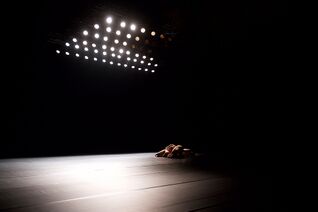Träumerei des Verschwindens
A piece by Lina Gomez / Lighting design Bruno Pocheron
Factual description by Emese Csornai
In the beginning of the performance we see a number of dancers very close to each other upstage left, well placed so we do not think about the limitations of the performing area. It is hard initially to make out how many they are. A small number of casually placed pars light them, the five dancers are playing in a silver tone with warm shadows over a black dance floor. As the bodies roll and turn on the floor towards the opposite diagonal, the space slowly opens up (as in bigger and bigger part of the space is revealed) with the movement. The movement raises feelings and questions in us regarding the body, typically about the mechanics of the body , the movement of different skeletons, and flesh, the perception of space shifting by this special strategy of passage. We have the chance to observe the bodies and the direction of the movement, as the rig slowly reveals itself.
Singing, guitar and electronics are performed live, and this gives a tangible fragile beauty to the whole performance, with a slow build-up, playing with time in a way it was for me difficult to grasp and quite suggestive, repetitive, hypnotic. In its build up both music and light appear like a very well executed improvisation.
The lighting setup is made of two main components, one of which is a rig lowered to the approximate height of 5m with around 70 pars, in a tight cluster. As the cluster is hung lower compared to the trusses of the room, it appears like an installation, and so being, the performing space is made more intimate. This cluster is denser and offset from the middle of the stage, but creates a regular wash on stage, an orderly matrix of each pixel being a par. This wash has a very high resolution, handled with a specific toolbox and run by hand, and has the appearance in action like weather/atmospheric shifts. Throughout the piece it resembles a mirror to the stage or another group of bodies gliding. The other component is a group of 3 pieces of 5kW Fresnels far front on the same diagonal the cluster finds itself, these lamps conclude the diagonal opening of the space, this is the brightest state.
After this big opening of the space, more diverse events take place, in the second part of the piece light is dealt with in an increasingly characteristic way, with faster shifts. The shifts become increasingly related to the music which gives the piece an immersive quality, and it makes the scale of the bodies smaller and the kinesthetic empathy stronger.
On one hand this is ever re-framing the audience gaze on the relation of space and dancers, darkness and light, contour and surface, on the other hand the movement of the lights increasingly behaves as another body in space. The last sequence I remember was bodies drifting stage left like autumn leaves and then there was a blackout.
Credits
IDEA/CONCEPT/CHOREOGRAPHY Lina Gómez
DANCE, CO-CREATION Diethild Meier, Julek Kreutzer, Camille Chapon, Bella Hager, Felipe Fizkal
LIVE MUSIC, CO-CREATION Michelangelo Contini, Gearóid Ua Laoghaire
SOUND COLLABORATION Ignacio Villa
LIGHTING DESIGN Bruno Pocheron
DRAMATURGICAL ADVISE Thomas Schaupp
PRODUCTION MANAGMENT M.i.C.A. - Movement in Contemporary Art
Artists involved in the 2015 version: Jacques André Dupont, Christina Wüstenhagen, Joshua Wicke
Träumerei des Verschwindens is a production by Lina Gómez. Funded by the Senate Department for Culture and Europe, in cooperation with Radialsystem.
An initial version of this work was initiated in 2015 during the Master Choreography at the Hochschulübergreifendes Zentrum Tanz Berlin (HZT) and shown in the frame of the Herbstprojekt MAC 2015.
The lighting designer's own description
Bruno Pocheron: " When I started to attend rehearsals of the first iteration of the Lina's project, back in 2015, it quickly became clear to me that the intricate simplicity, the continuous flow of the choreography and movement material called for their equivalents in terms of lighting. It was also evident to me that my light had to provide a strong, weather like, unpredictable environment to the five naked bodies evolving sometimes entangled, sometimes lonely on stage, while giving them some sort of protection, by outlining and highlighting the dancers bodies, without ever exposing them in a crude or obvious way.
In my perception, Träumerei des Verschwindens is a very sensual piece that celebrates the human body without emphasis on sexuality, it is a piece that questions genders and shows their fluidity without resorting to discourse, just by blurring the perceptions of the spectator and setting aside any affirmation of gender, making genders literally imperceptible by ways of choreographic choices.
To support that in lighting, I opted for the following set up: a cluster of 63 Pars concentrated on a grid space of about 8m x 8m, so quite tight together, upstage right, patched solo, focused as a diagonal back wash on the whole stage, filtered with lee 603 (moonlight white). As a counterpoint to the Pars cluster, 3 Fresnels 5 Kw, positioned over the last row of the audience, front of house left, focused as a diagonal front wash on the whole stage, filtered with lee 708 (cool lavender).
I programmed only one cue for the whole show, namely the audience light going down. Apart from that, I controlled the light manually, with a few faders and mainly a touchscreen interface controlling the Pars as a matrix, following, or counterbalancing the movement of the dancers, working with the music, or creating counterpoints to it.
Links
https://www.linapgomez.com/devaneios-sobre-o-desaparecimento
https://www.tanznetz.de/blog/30562/in-magisches-licht-getaucht
